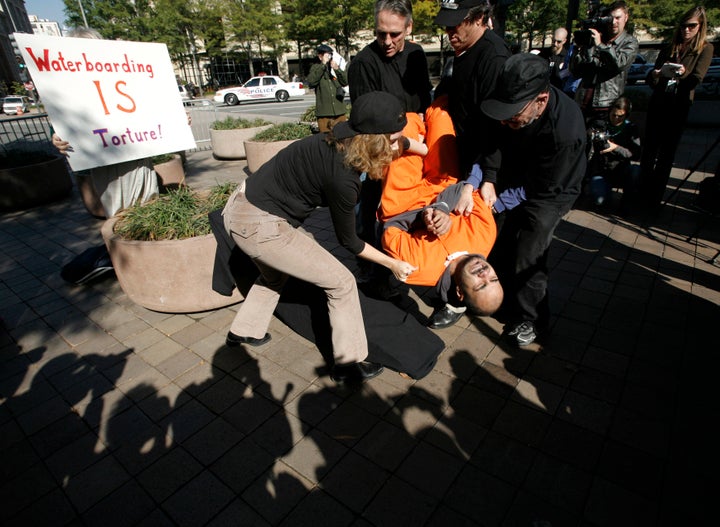WASHINGTON — On Wednesday, Gina Haspel, a veteran CIA officer who reportedly oversaw a secret prison in Thailand where an alleged terrorist was waterboarded and later helped destroy videotapes documenting interrogation sessions, will make the case to a Senate committee that she should be confirmed to be the director of the spy agency.
It will be the first time that Haspel, who has spent years undercover, will speak publicly about her career, and some lawmakers are urging the CIA to declassify documents that explain her role in the torture program. Haspel, the current acting director of the CIA, has never publicly atoned for her involvement in the now-defunct interrogation operation and the subsequent cover-up. If confirmed, she will serve under a president who campaigned on bringing back “a hell of a lot worse than waterboarding.”

When Haspel appears before the Senate committee for her confirmation hearing, lawmakers will not just be evaluating her record. They will be deciding whether overseeing torture is disqualifying. Because most of the people who were tortured by CIA officials, at times under Haspel’s watch, cannot tell their stories, HuffPost asked several people who have been waterboarded as part of mock interrogations or military training to describe the experience. (The military quietly banned the use of waterboarding in training in 2007 because it was too brutal, HuffPost reported in March.)
The people interviewed by HuffPost were waterboarded once, and they knew it was a controlled procedure. The CIA waterboarded one of its prisoners, Khalid Sheikh Mohammed, 183 times, according to a Senate report on the agency’s torture program.
George Wolske, former Navy aircrewman
Wolske was waterboarded during Survival, Evasion, Resistance, and Escape training in March 1969 at North Island Naval Air Station in San Diego when he was 25 years old. Now 72, Wolske says he still thinks about the experience.
I tell you, it was years ago when I went through it, but it was, perhaps the most searing, burning learning experience I’ve ever been through. The whole process is introduced and taught as an element of torture. And that it is. … The brief introduction to waterboarding [in SERE training] is so intense, so mentally violent, to the person on the receiving end, it is something you will never forget. You are actually brought to the point of thinking you’re going to drown.
It only takes a few minutes. It is that intense and that real. They put you down on a board, put you on your back, strap you down, you can’t move. They begin pouring water on your face. It’s going up your nose, you can’t breathe. In that flash of a moment, you recognize that the only thing that really matters in life is oxygen. You can do without a whole lot of stuff — but if you can’t breathe, you are going to die.
I always thought that George Bush and Dick Cheney should go on the waterboard and find out what that’s like. Likewise for Gina Haspel.
[Being waterboarded] is always in the back of my mind, it has never gone away. Honestly, for about three weeks afterward — I’m a very calm person normally ― but after that experience, for three weeks, any little sound, somebody poking me or brushing up against me, I would twitch, I would jump. I was on edge.
Chris Jaco, former military pilot
Jaco was waterboarded during SERE training at the Air Force Academy in 1970.
When it happened, we didn’t really know — heck, I was 19 years old — I didn’t really know what waterboarding was. It was to give you a feeling and understanding to know what it was like, what you might be able to expect if you were to be captured. …
It felt like you were choking to death on water and couldn’t stop it from being that way. I do remember — I’m a tall person, but not an extremely big person or a particularly strong person — but I was throwing people off of me because it was so overwhelming. When you’re choking on water, you’re not really thinking, “Wow, this is just training, I gotta see what it feels like.” You were a little afraid at the moment. It was like, I can’t breathe, water’s going up my nose and my throat was basically filled with water.
They would ask questions … you were to try to not answer them if you felt you could. I got to the point where I was just throwing people off of me and I ran out of the tent at the time. So I was finally subdued and put in a hot box. It’s a very, very small box with a door in it, you’re not usually in a very comfortable position. Usually, it’s in a very hot place. …
I would say military people need to have some types of experience to understand what could come. Now, when it comes to the waterboard, I believe there’s been enough movies and television shows that have shown fake waterboarding, that you kind of get an idea about it. I don’t think you would actually have to experience that. … You can extrapolate from the things you’ve already experienced in SERE training of what it might be like without actually have to be choked almost to death by water.
Jeromy Shane, former Army interrogation instructor
Shane was waterboarded in 2003 during SERE training at Fort Bragg, North Carolina.
It was the worst thing I’ve ever felt. Because when you’re being waterboarded, you’re actually inhaling water. … There’s no way to tell your body that this is going to end. Your body thinks you’re drowning and stops acting appropriately. ... It’s physically painful. I don’t know if you’ve ever gotten water up your nose while you’re swimming. It’s that over and over again until who’s doing it makes it stop. You’ve got water in your lungs, your brain is on fire, your nasal cavity is on fire, your throat is completely swollen up.
Malcolm Nance, retired interrogator
Nance was waterboarded in 2006 during SERE school at North Island Naval Air Station in San Diego. An outspoken critic of the use of torture, Nance testified in 2007 about the experience of being waterboarded before a congressional panel and the U.S. Helsinki Commission. The Pentagon banned the use of waterboarding in SERE training shortly after he testified. Here are excerpts from his testimonies:
Waterboarding is not a simulation. Unless you have been strapped down to the board, have endured the agonizing feeling of the water overpowering your gag reflex, and then feel your throat open and allow pint after pint of water to involuntarily fill your lungs, you will not know the meaning of the word. … Waterboarding is slow motion suffocation with enough time to contemplate the inevitability of black out and expiration — usually the person goes into hysterics on the board. For the uninitiated, it is horrifying to watch and if it goes wrong, it can lead straight to terminal hypoxia. When done right it is controlled death. Its lack of physical scarring allows the victim to recover and be threaten[ed] with its use again and again.
In my case, the technique was so fast and professional that I didn’t know what was happening until the water entered my nose and throat. It then pushes down into the trachea and starts to process a respiratory degradation. It is an overwhelming experience that induces horror, triggers a frantic survival instinct. As the event unfolded, I was fully conscious of what was happening: I was being tortured.
Chris Sampson, journalist and researcher
Sampson volunteered to be waterboarded in 2015 as part of a BBC documentary. While pouring the water into his nose and mouth, the “interrogator” asked him if he was born as a bunny rabbit. Sampson said yes. He was waterboarded for 18 seconds.
The water starts filling up my nasal cavity, turning me into an inverted water vessel. Going through my nasal cavity, it started to hit my throat. That’s when you see me physically convulsing, trying to fight off the board. … Once it started hitting a sort of critical point, my brain says, “Go negotiate this somewhere else” — which is when you see me say, “Yes … yes, I was born a bunny rabbit.”
That’s clearly an insane response. If the question had been, “Do you run around trying to bomb things? Are you a member of al Qaeda? Do you wear a tutu in the morning?” — anything you’re asked, you’re going to comply with because your natural survival skills are going to take over. …
I spit up a big chunk of water, I had it all in my sinuses, my whole nasal cavity filled out, my throat filled up, it was just beginning to hit my esophagus going upward. I had zero cognitive relationship to what they were asking as it was occurring.
Charlie Thompson, former naval aviator
Thompson wrote for Mic in 2012 about being waterboarded at a SERE training facility near Warner Springs, California.
A wet bath towel was placed over my face covering my mouth, nose and eyes and the water flowed continually. The first sensation is that of suffocation followed shortly thereafter by being unable to expel water that had saturated the towel and gotten ingested or inhaled. We were eventually told that this sensation was that of drowning. And, this is probably correct.
In any event, my ears began to ring and lights flashed in behind my unseeing eyes and my struggles abated. However, just before I lost consciousness, the ... officer ordered “stop” and the towel was removed. He then repeated the question I’d avoided and coughed, gagged, spluttered out “USS Guppie.” Continue, he ordered, and the process was repeated, but the next time when asked what ship I’d flown from I answered that it was the Constellation.
This was apparently a satisfactory answer (though it was a lie since I clearly hadn’t flown off any ship). He then ordered that I be taken off the board. When the restraints were removed, I rolled off the board and onto my hands and knees. I could not have stood up if my life depended on it. And I remained there vomiting water, and gasping for breath when I was asked “You bomb peace loving people in city… you kill women and children?” I shook my head in the affirmative.
At that point I’d have confessed to being the reincarnation of Jack the Ripper if it meant I could avoid another session on ― I shiver when I say it ― the infamous waterboard.

